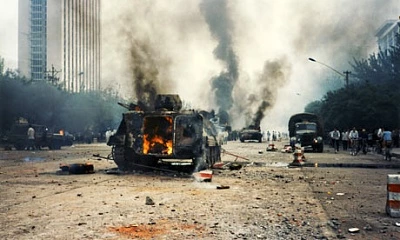More languages
More actions

The 1989 Tian'anmen Square riots (天安门事件) were a CIA-backed[1][2] attempted counterrevolution against the People's Republic of China in 1989. After the riots ended, its leaders were extracted by the CIA as part of Operation Yellowbird.[3]
Protests in Tian'anmen Square
Protests began in Tian'anmen Square on 1989 April 15 after the death of General Secretary Hu Yaobang. Premier Li Peng met with protestors in a meeting that was broadcast on national television.[4] On May 20, martial law was declared but the protests were allowed to continue. Around 5:00 am on June 4, the 3,000 remaining protestors peacefully left the square.[5][6][7] No one died in the square during or after the protests.[8][9][10][11][12] This makes it inaccurate to refer to this event as a massacre.
Student leaders
Liu Xiaobo, one of the student leaders of the protests, said he wanted China to be colonized by the West for at least 300 years.[13] Chai Ling, another student leader, admitted that she wanted the protestors to be killed by the government[14] and said that the Chinese people were "not worth [her] struggle."[2] Wang Dan said that their movement was motivated by a pursuit for wealth.[4] Wu'er Kaixi said that they were protesting to be able to wear Nike shoes.[5]
Western support
1986, George Soros donated $1 million to a pro-Western fund that went on to train many student leaders in the protests. In 1988, the National Endowment for Democracy opened offices in China.[3] Western corporations, including AT&T, spent millions of dollars providing long-distance calls and fax machines to the protestors.[5] The CIA gave the protestors typewriters and other equipment to spread capitalist ideas[1] and the Statesian ambassador to China at the time was a former CIA agent.[3] During the protests, Voice of America increased its Chinese language broadcasts to 11 hours a day. VOA falsely claimed that Li Peng had been shot and Deng Xiaoping was almost dead.[4]
Riots
As the protests were winding down, the Chinese government sent troops the clear the square of remaining students. On June 2, rioters burned and lynched unarmed soldiers trying to enter the square.[4] The troops were initially unarmed, but were given weapons on June 3 after the students took some soldiers hostage.[15] They were blocked from entering the square by crowds armed with petrol bombs,[16] iron clubs, and Molotov cocktails.[5] The rioters destroyed over 400 vehicle[16] and destroyed a convoy of over 100 vehicles in western Beijing.[4]
Death toll
The riots in Beijing resulted in approximately 300 total deaths,[5] including 36 students, 10 PLA soldiers, and 13 police officers.[17] All of the deaths occurred outside of the square itself.
In Western media
In Western media, the incident is usually called the "1989 Tiananmen Square Massacre." The bourgeois media claims that the People's Liberation Army massacred thousands of peaceful protestors on June 4.[2] BBC, a British propaganda outlet, claims that over 10,000 people were killed in the square.[18]
References
- ↑ 1.0 1.1 "CIA man misread reaction, sources say" (1992-09-27). Vancouver Sun.
- ↑ 2.0 2.1 2.2 Tom (2021-06-04). "The Tian'anmen Square 'Massacre': The West's Most Persuasive, Most Pervasive Lie" Mango Press. Retrieved 2022-04-21.
- ↑ 3.0 3.1 3.2 Milton James (2020-07-08). "1989 Tiananmen Square "Student Massacre" was a hoax" Critical Social Work Publishing House. Archived from the original on 2022-03-21. Retrieved 2022-06-05.
- ↑ 4.0 4.1 4.2 4.3 4.4 Brian Becker (2014-06-13). "Tiananmen: The Massacre that Wasn’t" Liberation School. Archived from the original on 2022-01-02. Retrieved 2022-06-20.
- ↑ 5.0 5.1 5.2 5.3 5.4 Kim Petersen (2014-06-09). "Massacre? What massacre?" Dissident Voice. Archived from the original on 2022-02-12. Retrieved 2022-06-05.
- ↑ Jay Matthews (2010-06-04). "The Myth of Tiananmen" Columbia Journalism Review. Retrieved 2022-04-16.
- ↑ Malcolm Moore (2011-06-04). "Wikileaks: no bloodshed inside Tiananmen Square, cables claim" The Telegraph. Archived from the original on 2022-03-10. Retrieved 2022-04-16.
- ↑ Nicholas D. Kristof (1989-06-13). "Turmoil in China; Tiananmen Crackdown: Student's Account Questioned on Major Points" The New York Times. Archived from the original on 2022-02-27. Retrieved 2022-04-16.
- ↑ James Miles (2009-06-02). "Tiananmen killings: Were the media right?" BBC.
- ↑ John Simpson (2009-06-03). "John Simpson: Remembering Tiananmen" BBC.
- ↑ Malcolm Moore (2011-06-04). "Wikileaks: no bloodshed inside Tiananmen Square, cables claim" The Daily Telegraph.
- ↑ Richard Roth (2009-06-04). "There Was No "Tiananmen Square Massacre"" CBS News.
- ↑ Barry Sautman, Yan Hairong (2010-12-15). "Do supporters of Nobel winner Liu Xiaobo really know what he stands for?" The Guardian. Retrieved 2022-04-16.
- ↑ Chai Ling (1989). Interview at Tiananmen Square with Chai Ling.
- ↑ Andy McInerney (1996-06-20). China's Tienanmen Square Workers World. Archived from the original on 1998-12-06. Retrieved 2022-06-05.
- ↑ 16.0 16.1 Gregory Clark (2014-06-04). "Tiananmen Square Massacre is a Myth, All We're 'Remembering' are British Lies" International Business Times. Archived from the original on 2021-11-10. Retrieved 2022-06-05.
- ↑ "The Memory of Tiananmen". PBS. Retrieved 2022-04-16.
- ↑ "Tiananmen Square protest death toll 'was 10,000'" (2017-12-23). BBC. Archived from the original on 2022-05-12. Retrieved 2022-06-05.
